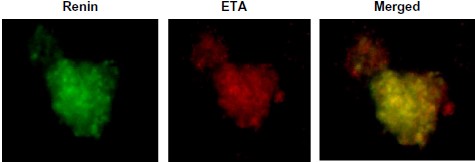Overview
- Peptide (C)NHNTERSSHKDSMN, corresponding to amino acid residues 413-426 of rat ET-A (Accession P26684). Intracellular, C-terminus.
- Rat brain membranes (1:200).
 Western blot analysis of rat brain membranes:1. Anti-Endothelin Receptor A Antibody (#AER-001), (1:200).
Western blot analysis of rat brain membranes:1. Anti-Endothelin Receptor A Antibody (#AER-001), (1:200).
2. Anti-Endothelin Receptor A Antibody, preincubated with Endothelin Receptor A Blocking Peptide (#BLP-ER001).
- Rat brain sections and rat lung paraffin embedded section (1:100). Mouse retinas (Bramall, A.N. et al. (2013) PLoS ONE 8, e58023.)
- Mouse isolated juxtaglomerular (JG) primary cells (1:100) (Ortiz-Capisano, M.C. (2014) Physiol. Rep. 2, e12240.).
The endothelin system is comprised of three active peptides, ET-1, 2, and 3, which are considered to be very powerful vasoconstrictive substances. In humans, endothelins mediate their actions via two specific G-Protein Coupled Receptors, ETAR and ETBR. Both ETAR and ETBR are present in heart and in human myocardium at similar levels.1,2
The endothelin receptors differ in their ligand specificity. While ETAR has varying affinities for the endothelin isoforms (ET-1 >ET-2>ET-3), ETBR shows no selective affinity.2,3 Subsequent studies have demonstrated the presence of endothelins in vascular as well as in non-vascular cells and tissues, having multiple biological activities.
Currently, there is increasing evidence that ET-1 may modulate mitogenesis, apoptosis, angiogenesis tumor invasion and the development of metastases.3
Overexpression of ET-1 and ETAR was reported in different malignancies including prostate cancer human Kaposi’s sarcoma, ovarian and breast carcinomas.4
In breast carcinomas overexpression of ET-1 and ETA receptors correlated with parameters that characterize aggressive types of breast cancer suggesting that analysis of ETAR expression might be used as a diagnostic marker for evaluating the progression of the disease and effectiveness of treatment. These and other findings have made ET receptors, and especially ETAR, promising therapeutic targets for pharmacological intervention.5-9
Application key:
Species reactivity key:

Expression of Endothelin Receptor A in mouse JG cells.Immunocytochemical staining of mouse isolated juxtaglomerular (JG) cells using Anti-Endothelin Receptor A Antibody (#AER-001), (red). ET-A staining co-localizes with renin, a kidney cell marker, (green).Adapted from Ortiz-Capisano, M.C. (2014) Physiol. Rep. 2, e12240. with permission of the American Physiological Society and The Physiological Society.
